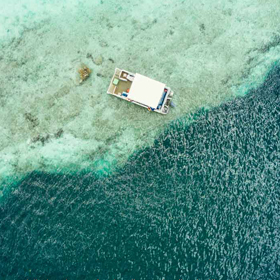- Walking Namibia's trails: between bush, desert and lagoon, observing giraffes, zebras and dolphins
- Charming lodges, private accommodation as close to nature as possible; seamless logistics
- Namib Dunes, Etosha Park, Swakopmund, Oryx, Khoikhoi Rock Art
- You'll have access to our additional services, including our local Concierge
Contact one of our specialists + 44 (0) 20 3958 6120
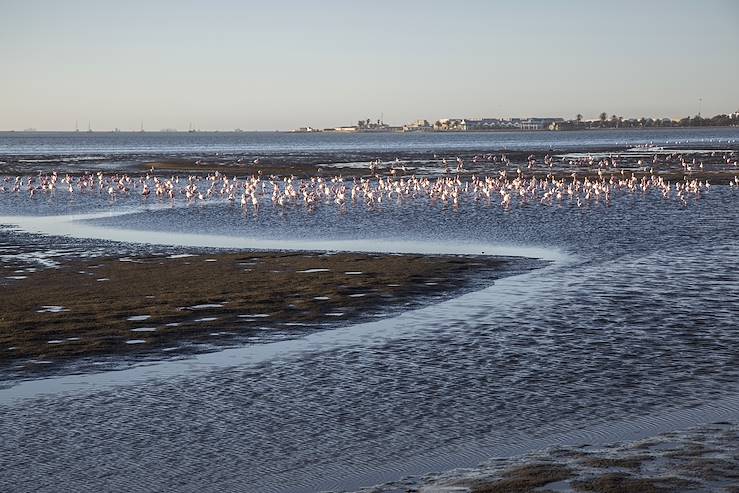
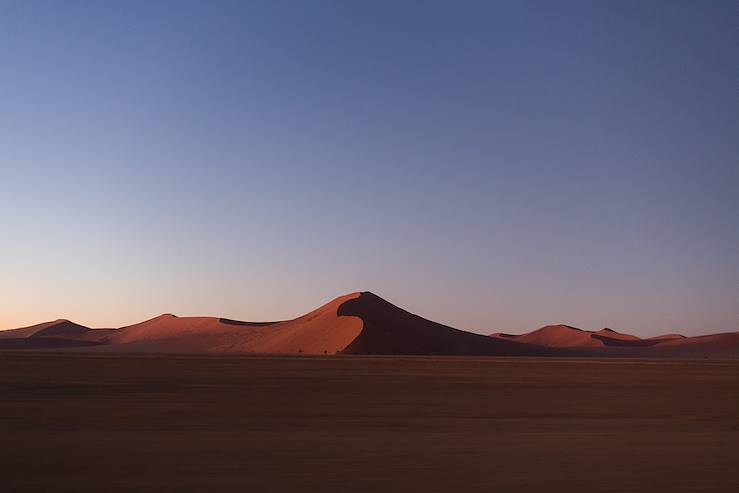

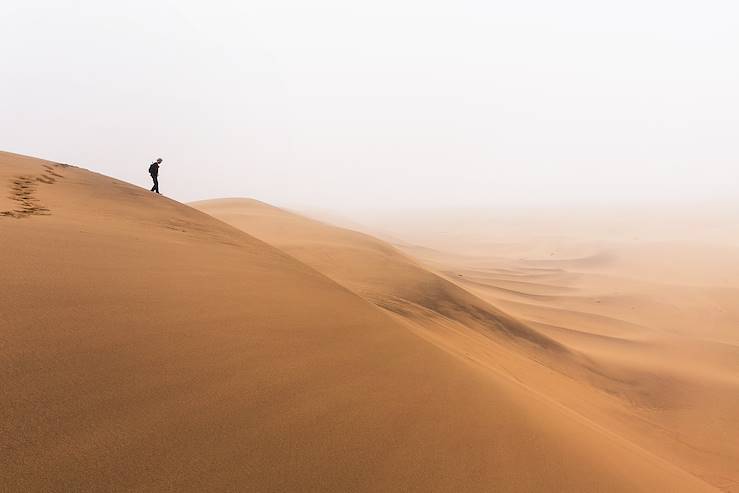
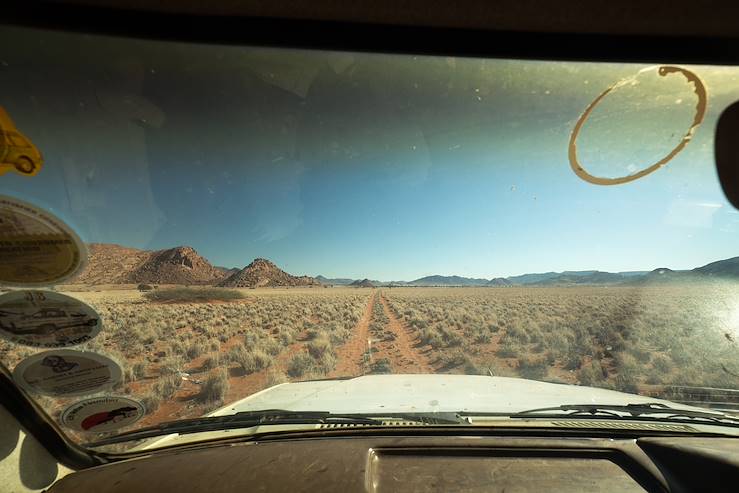
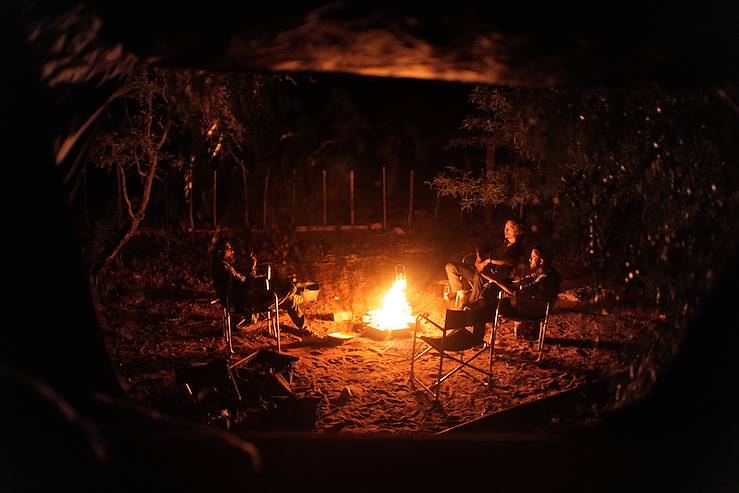
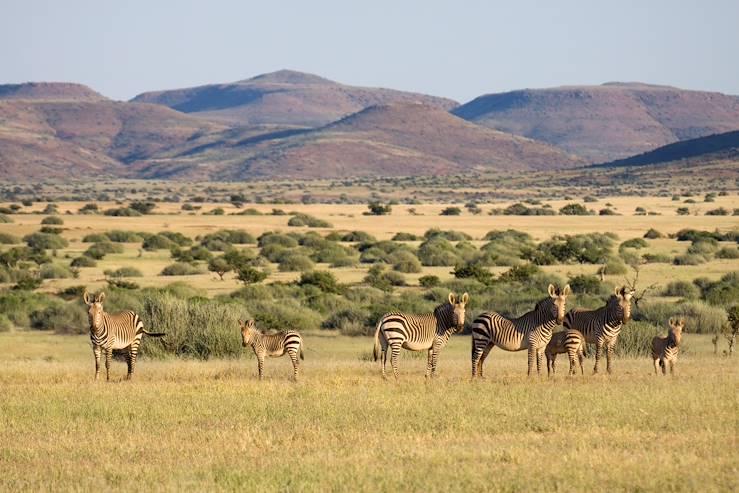
Namibia All the Way
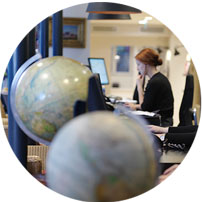
Your journey
Although you have along journey ahead of you, you'll be able to sit back and take in the landscape. You'll have an 4x4 or SUV depending on the season; GPS and a picnic packed up for you. The route itself generally follows nice roads that are easy to navigate. At the stops, lodges - pleasant comfort and atmospheric, with nature all around. Half board everywhere except Windhoek and Walvis Bay. Namibian cuisine is given a modern twist. The itinerary includes a tour of the Marlice van Vuuren Foundation in Windhoek, a conservation and development initiative that is well worth checking out. For the rest, it's completely up to you. We can provide lots of suggestions for what to do, or our local Concierge can help you out with any last minute recommendations. We've planned your itinerary to the finest detail so that you can focus on enjoying yourself. If, along the way, you have a sudden urge or a slight issue, contact our local Concierge service for support and advice: they offer great service and know the country, with a wealth of diverse knowledge.Route
Flight to Windhoek
Airport reception and assistance. Pick up rental vehicle. Drive to the lodge, about 30 minutes north-east of Windhoek. out in the wilderness. The contemporary buildings are made from sustainable materials, in a chic and comfortable eco-design. Individual bays and verandas open onto rough landscapes, where hartebeest, gemsbok, greater kudu, giraffes, and baboons roam. The chef offers a modern take on traditional regional food and magics up a new African cuisine. After the flight, the swimming pool is the perfect opportunity to happily unwind. The residence's environmental stewardship also extends to the region's San people, who it has involved in running a foundation.
Windhoek - Otjiwarongo
Already included in the itinerary - The Marlice van Vuuren Foundation. Its mission is to support the San people and preserve the natural environment. The tour with a local guide helps shed light on these linked issues. You'll start off with animals being reintroduced back into their natural habitats: care, feeding, helping them to be self-reliant. Daktari west coast. Then a trip to Clever Cubs School, which was founded around the issue of integrating the country's first inhabitants into Namibian society.
Drive to Otjiwarongo. Overnight stay about 30 miles north-east. The thatched-roof bungalows at the lodge are located in well-manicured gardens. Beyond that lies the grasslands, dotted with acacias. The protected areas is home to antelope and guineafowl. A beautiful traditional enclosure houses a swimming pool and sun deck. The rooms are comfortable, ventilated, modern African, and well-equipped. Mats cover the floor. The restaurant offers outdoor vistas, for uninterrupted viewing.
Otjiwarongo - East Etosha
Otjiwarongo, the capital of the Otjozondjupa region and a major northbound road link, and still has interesting buildings dating from the German period. The Cheetah Conservation Fund is based there. A little to the east, Waterberg Plateau Park offers a huge landscape that is home to rare species.
Drive to Etosha National Park. Enjoy two nights' accommodation in the Onguma Private Reserve. The lodge is next to a watering hole. As the lounge and dining room have prime views overlooking the watering hole, it is common to spot the animals coming to drink as you sip a cocktail or enjoy a sumptuous meal. It's a sort of dine-in safari. The bungalows with their grey thatched roofs are quintessentially African. It is discreetly integrated into the surrounding natural environment. The rooms cannot be faulted. It's not Olympic size, but there is a handy swimming pool that does the job. The staff are attentive and efficient, all further enhancing the fantastic feel of the place.
East Etosha
To see the fabulous landscapes and abundant wildlife living in harmony, enjoy safaris in kitted out vehicles organised by the lodge. The best time to see animals is at sunrise and sunset. You'll board a specially equipped vehicle with a ranger and go off in search of hartebeest (Alcelaphus buselaphus), impala (Aepyceros melampus), common eland (Taurotragus oryx) and other cheetah (Acinonyx jubatus) in the bush. In the clear bright colours of the morning and the fiery glow of the evening sky, these are truly memorable animals encounters Hiking in the bush, with a tracker, adds a palpable thrill to these encounters. Listen, feel, look around and interpret the signs. The 'book of nature' isn't just a throwaway phrase here, it's a daily reality: the bush is an open book, where knowledge can mean life. To live in this part of the world, the ability to read the landscape and pick up signs is vital. And those who can do this deserve our full respect.
East Etosha - Vingerklip
Drive to the Ugab Valley, between Outjo and Khorixas. Two-night stay in a truly quintessential African lodge. The architecture is lovely, and the facilities and facilities are excellent. The bright, ventilated rooms ensure perfect privacy and offer great relaxation. Terraces give you some outdoor space, where two pools and a hot tub await guests. After around ten minutes' walk up onto a high spot, you'll reach the house's rotunda restaurant serves Namibian cuisine with a flourish. The steep path requires an effort but the meal and stunning view of the valley more than make up for it.
Vingerklip
Around the lodge, the landscape looks like an African version of Arizona. The Vingerklip or 'stone finger', is a 110ft-tall limestone pinnacle, shaped by erosion. It rises up alone on the top of the hill, and can be seen from the lodge restaurant. This is the eastern entrance to Damaraland. The rock art site of Twyfelfontein, in the Huab Valley, is a must-see. The hunter-gatherers of the Stone Age, and then the Khoikhoi herders, adorned the site with petroglyphs and paintings. Slender images of giraffes, lions, antelopes, elephants and bow hunters evocatively brought to life. It is now a UNESCO World Heritage site. In the Brandberg mountain range, the San people also left behind numerous paintings. About 18 miles from Khorixas, the fallen trunks of the petrified forest are between 250 and 300 million years old. It's a mindblowing thought.
Vingerklip - Walvis Bay
Drive to Walvis Bay. Accommodation for two nights in a colonial-style hotel, a stone's throw from the lagoon. The rooms have a simple elegance, and are an ideal respite from the heat of the sun. There is international, Mediterranean-inspired cuisine. The lounge is ideal for socialising. The swimming pool is located in the garden, a sky blue rectangle perfect for relaxing after the journey or sightseeing.
Walvis Bay
A 1932 black-and-white lighthouse stands at the tip of the shoreline, but it isn't the main reason for grabbing the paddles and heading out into the water, it's more for the Heaviside's dolphins, common bottlenose dolphins, the colony of fur seals, lesser flamingos and white pelicans. This small corner of the world is blessed by the bounty of the Atlantic. Southern right whales are common visitors to these shores - what the Germans used to call 'Whale Bay'. The lagoon and the wildlife it attracts are Walvis Bay's main appeal, a former South African enclave with a checkerboard plan and nominal architecture. There is a much greater architectural appeal to be found here though: Swakopmund. A small late 19th-century German town, around 30 miles to the north. It now serves as a smart seaside resort. The iconic buildings include the Lutheran church dating from 1911, the old barracks built in 1906 - flanking the Hotel Prinzessin Rupprecht, a former Art Nouveau military hospital, built in 1902 - or the Hohenzollernhaus, built between 1904 and 1906, in the Neo-Baroque style. You can even see the 'Welwitschia mirabilis', an extraordinary unique plant on the arid coastline - included in the country's coat of arms with the sea eagle and oryx - some live specimens are over a thousand years old.
Walvis Bay - Sesriem
Drive to Sesriem. Enjoy a two-night stay at the foot of the Naukluft Mountains, between Sesriem and Sossusvlei. The bungalows are spread across a slope, around a large central unit, and look out onto a fascinating endless and dry landscape, with vast expanses stretching as far as the eye can see. The accommodation uses canvas, wood and various recycled materials, but it is still incredibly comfortable. The rooms are equipped with beautiful bedding and a bathroom. Each unit has an outdoor pool. The beds are slightly raised for optimal outdoor views. The restaurant offers a twist on Namibian cuisine and the bar serves divine cocktails on the semi-circular terrace.
Sesriem
Sesriem is the gateway to the Namib-Naukluft National Park, the largest of Africa's parks: At 19,000 square miles, it is slightly bigger than Slovakia. Away from the Atlantic coast, it's a generally arid region, and in some areas completely arid. The wildlife here has learned to survive, and some of the techniques are being harnessed by cutting-edge industry. Although the Rüppel's bustard lives normally its species, the gemsbok has a sophisticated system for regulating its temperature. And the fog stand beetle has captured the interest of researchers at MIT, intrigued by its method of capturing moisture from the air. The Sossusvlei region, a salt desert in a sand desert, is famous for its sea of sand dunes. They are orange sand dunes that change colours in the light and stand more than 1,000ft tall. Acacias act as wells, and collect water from as far down as 30ft. It's an unparalleled landscape.
Sesriem - Aus
Drive to Aus. Overnight stay is in a lodge with bungalows reminiscent of old time karas farms. The rooms offers a rustic elegance and don't scrimp on comfort. They provide a nice sense of balance, a good place to recharge in a supersized natural landscape. Terraces are ideal for enjoying the mild morning and evening air. The restaurant serves solid Namibian fare. With a spot of luck, you can spot klipspringers in the nearby rock formations, but wild horses are the area's big attraction. Probably deserters from the German army during World War I, they made the desert their home, which was made a little easier by a water source that was installed there at the start of the 20th century. Around 60 miles to the west, the coastal town of Luderitz has preserved beautiful examples of German architecture; nearby, the ghost town of Kolmanskop, is a vestige of the diamond rush.
Aus - Fish River Canyon
Drive to Fish River Canyon. Two nights' accommodation in Gondwana Nature Park, 12 miles east of the gorges. A lovely garden between piles of boulders, stone and wood bungalows, and an outdoor pool all help create a very pleasant lodge. In the main building you'll find a dining room, lounge and bar. The terraces overlook the steppe, with its patches of Aloe dichotoma.
Fish River Canyon
The sheer size of the site is impressive. You'll drive to the viewing points. After studying the entire 100-mile site on a map, seeing sections of it for real gives an even better sense of just how spectacular it is. At the bottom, the Fish River flows intermittently, emptying its sparsely flowing stream into the Orange River in South Africa. Several ecosystems share the region. One of these, the lush steppe, has stunning examples of how plant life adapts to the arid conditions, capturing and storing water. One example is the 'Pachypodium namaquanum', which looks like an elephant's trunk; 'Euphorbia clavarioides', a cushion plant; 'Cotyledon orbiculata', with its flowers at the end of a long stalk… Among the animals in this area are the graceful steenbok, ostrich and Hartmann's zebra.
Fish River Canyon - Kalkrand
Drive to Kalkrand. The landscape of the Kalahari is made up of long lines of reddish dunes separated by roadways, wide grassy plains where the acacias create a little shade. Large animals come to feed here, such as wildebeest, giraffes, kudus, oryx, etc. Yet the star of the show is only one foot tall and has no tail: the meerkat. These lovable creatures are all around.
Spend the night at the end of the track, on the edge of the bush. The restaurant, bar and pool are in Kalkrand, and your tent is about two miles away raised up on a platform, above the savannah. It's perfect for peace and quiet. The last night gives an unforgettable encounter with the widen open space. The accommodation has its own separate shower room, accessible by a simple walkway. Every little detail is catered for even in the huge limitless expanse. The communal areas back two miles the other way, fostering a pioneering spirit and serving family cuisine.
Kalkrand - Windhoek - return flight
Drive to Windhoek Airport and return car. Return flight.
A la carte
It's a new day and the rich mineral hue of the landscape is adorned with pearlescent pink. The perfect silence is broken only by the burner firing. It's a really beautiful moment before you head back on the ground for a champagne breakfast, the air now filled with excited conversation about the heavenly experience.
Option - Half day
A Rough Idea of Price
- Return scheduled flight to Windhoek
- Airline taxes and fuel surcharge
- Reception and assistance at Windhoek Airport
- 12-day rental of a 4x4 vehicle
- Overnight stay near Windhoek in a double room, half board
- Tour of the Marlice Van Vuuren Foundation
- Overnight stay in Otjiwarongo in a double room, half board
- Two-night stay in Etosha, half board in a double room
- Two-night stay in Vingerklip in a double room with half board
- Two-night stay in Walvis Bay in a double room with breakfast
- Two-night stay in Sesriem in a double room with half board
- Overnight stay in Aus in a double room, half board
- Two-night stay in Fish River Canyon in a double room, half board
- Overnight stay in Kalkrand in a double room with half board
- Our local Concierge service
Our local concierges
Travel diary app
UK airport lounge
CO2 absorption

